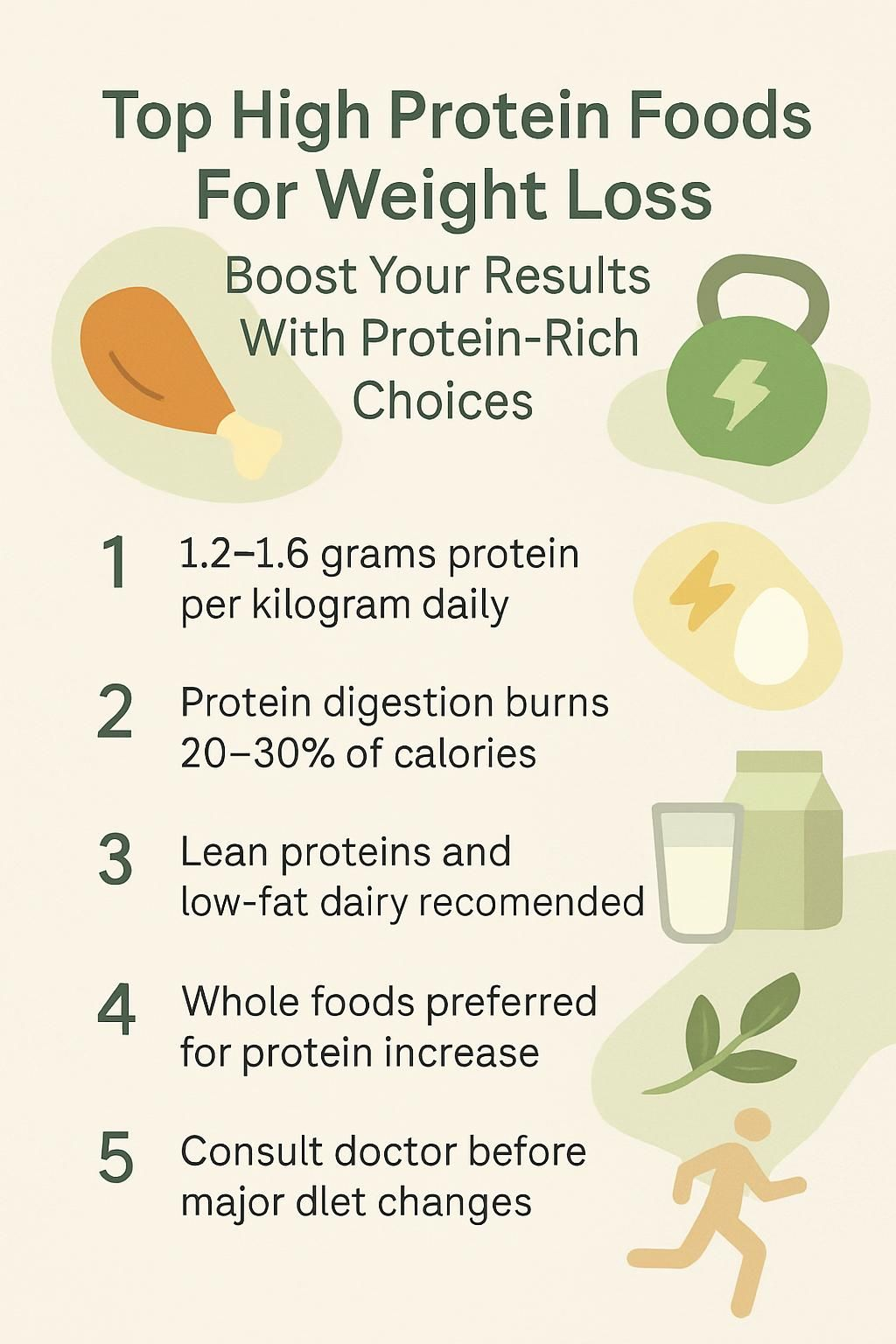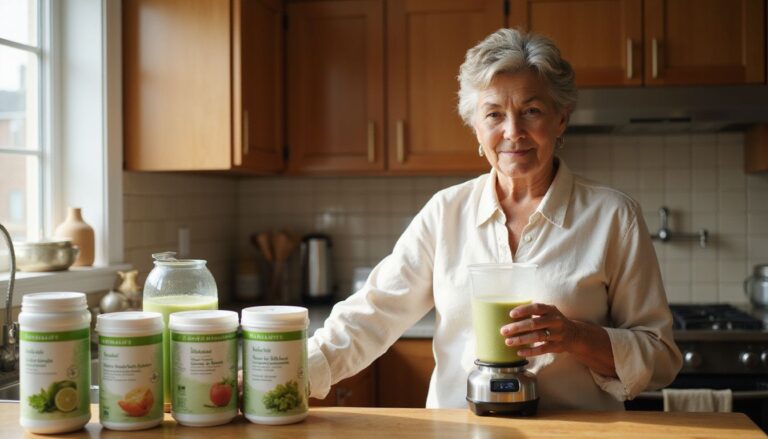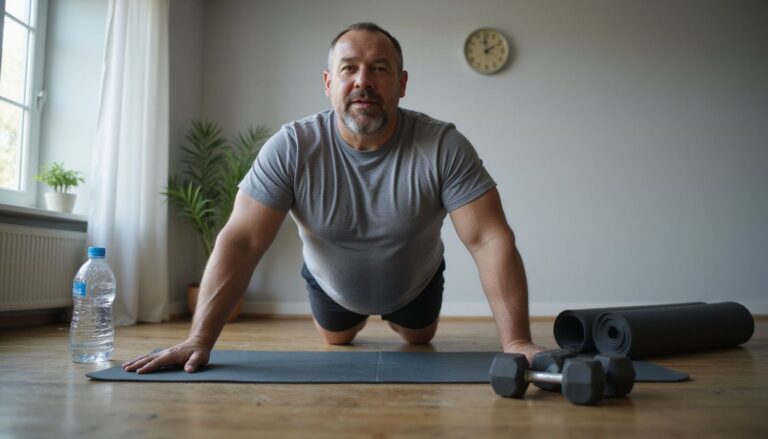Top High Protein Foods For Weight Loss: Boost Your Results With Protein-Rich Choices
Our Nutrition Assistant AI Suite will transform your body. You will lose fat, get toned, and build muscle. Gain confidence and optimal health.
Feeling stuck with cravings or low energy during weight loss is common. Choosing high-protein foods can help you feel fuller for longer and protect muscle as you cut calories. This guide shows simple protein choices, from chicken breast and Greek yogurt to lentils, eggs, oats, and salmon, that are low in calories and rich in nutrition.
You will see how to add these foods to meals and snacks without losing flavor. Small changes add up and can move the scale in the right direction.
Key Takeaways
- High-protein foods such as chicken breast, Greek yogurt, lentils, eggs, oats, and salmon help you feel fuller and protect muscle during weight loss.
- A daily intake of 1.2 to 1.6 grams of protein per kilogram of body weight supports lean mass while dieting (Leidy HJ et al., 2015).
- Protein has a higher thermic effect. Your body burns 20 to 30 percent of protein calories during digestion compared with 5 to 10 percent for carbs and 0 to 3 percent for fat.
- Pick lean meats, low-fat dairy, beans, seafood, nuts, and seeds to raise protein intake without too much saturated fat or sugar.
- Increase protein gradually with whole foods. Talk with a clinician first if you have medical conditions or special nutrition needs.

Why Protein is Essential for Weight Loss

Protein helps you stay satisfied on fewer calories. Think of it as a steady anchor during a calorie deficit.
How does protein promote fullness and reduce hunger?
Protein takes longer to digest than fat or carbohydrates, which helps you feel full after a meal. It can lower ghrelin, the hunger hormone, and raise peptide YY, a hormone that promotes satiety.1 Adding chicken breast or Greek yogurt to meals can steady energy and cut snacking.
Eating four or five smaller, protein-rich meals may also help manage appetite and support weight loss results.2 Many people find they naturally eat fewer calories when protein intake rises.
References: 1) Leidy HJ et al., Am J Clin Nutr 2015;101:1320-9. 2) Paddon-Jones D et al., Curr Opin Endocrinol Diabetes Obes 2009;16:69-75.
How does protein help preserve muscle during calorie deficits?
Without enough protein, your body may break down muscle for energy during weight loss. Muscle burns more calories at rest than fat, so losing it can slow progress. Eating protein at each meal supplies essential amino acids, the building blocks your muscles need to repair and grow.
Research suggests 1.2 to 1.6 grams of protein per kilogram of body weight can help preserve lean mass while you lose fat.1 Include complete proteins, such as fish, eggs, dairy, tofu, or tempeh, across the day to support strength and energy.
Including protein-rich foods at every meal supports muscle health even when you eat fewer calories.
How does protein boost metabolism and calorie burning?
Protein raises calorie burn through the thermic effect of food, which is the energy needed to digest and process what you eat. Your body uses about 20 to 30 percent of protein calories during digestion. Carbs use about 5 to 10 percent, and fat uses roughly 0 to 3 percent.
Choosing lean protein such as eggs, Greek yogurt, tofu, or grilled poultry can lift daily energy burn slightly. This helps you maintain a calorie deficit without feeling sluggish.
Animal-Based High-Protein Foods
Animal proteins supply all essential amino acids in one food, which makes meeting your needs simpler. Pick lean options to support heart health as you cut calories.
What makes chicken breast a good protein choice?
Skinless chicken breast is a lean, convenient source of complete protein. A 3 ounce cooked serving has about 26 grams of protein with very little saturated fat. Grilling or baking keeps calories low and flavor high.
It fits almost any meal plan and supports heart health better than many cuts of red meat that are higher in saturated fat. Turkey breast offers similar benefits and is an easy swap.
I added grilled chicken breast to my lunch salads and felt full much longer.
Why choose turkey breast for protein?
Turkey breast delivers about 26 grams of protein per 3 ounce cooked serving with less than 2 grams of fat. It is lower in saturated fat than many cuts of red meat. You also get B vitamins, selenium, and zinc, which support energy and immune function.
Add sliced turkey to salads, wraps, or grain bowls for a lean boost that keeps calories in check.
How does lean beef support weight loss?
Lean beef, such as cuts labeled loin or round, provides 19 to 26 grams of protein per 100 grams with less total fat. Choosing leaner cuts supports muscle maintenance while controlling saturated fat intake.
Beef also supplies iron and zinc, minerals that help keep energy up during weight loss. Swap higher fat steaks for lean sirloin to reduce calories and still get a strong protein dose.
Is pork loin a healthy protein option?
Pork loin is a lean choice with roughly 19 to 21 grams of protein per 100 grams. It has much less saturated fat than bacon or ribs. Trim visible fat and roast or grill to keep calories low.
Use pork loin in meal prep for quick, high-protein plates during busy weeks. It helps you reach protein goals without adding excess fat.
What are the benefits of fish like salmon, tuna, and cod?
Fish are complete proteins and tend to be lower in saturated fat than many meats. A 3 ounce portion usually provides 17 to 20 grams of protein. Salmon adds omega-3 fatty acids, which support heart health.
Tuna and cod are light, versatile options for low-calorie meals. Include seafood weekly to raise protein intake and support overall health.
How do shellfish like shrimp, crab, and scallops provide protein?
Shellfish deliver a lot of protein for few calories. For every 100 grams, shrimp has about 19 grams of protein, crab about 18 grams, and scallops close to 17 grams. Fat and saturated fat stay low.
Top salads with grilled shrimp, add crab to whole-grain pasta, or pair seared scallops with steamed vegetables. These choices raise protein without many extra calories.
Dairy and Egg-Based Protein Sources
Eggs and dairy are budget friendly and easy to prepare. They provide complete protein and helpful minerals for bone and muscle health.
Are eggs and egg whites good for weight loss?
Yes. One large egg has about 6 grams of complete protein plus vitamins like B12 and D. Egg whites are almost pure protein with very few calories. Using both whole eggs and whites gives you fullness and flexibility.
Scramble eggs for breakfast or pack hard-boiled eggs for a snack. They fit well in a high-protein diet for weight loss.
How does Greek yogurt contribute protein?
Greek yogurt is strained to remove liquid, which concentrates the protein. A 4 ounce serving of plain, low-fat Greek yogurt provides about 6 grams of protein and minimal sugar.
Enjoy it as a snack, blend into smoothies, or mix with chia seeds. It contains all essential amino acids and supports muscle repair during a calorie deficit.
Why include cottage cheese in a high-protein diet?
Low-fat cottage cheese packs about 12.4 grams of protein per half cup. It is satisfying and pairs well with berries or oats for fiber. You also get calcium and phosphorus, which support bones and muscle function.
Use cottage cheese as a quick snack or as a base for savory bowls with vegetables and herbs.
Is low-fat or skim milk a good protein source?
Low-fat and skim milk offer around 4 grams of protein per 4 ounces with less fat. They deliver calcium and vitamin D, which support bone health. Pour over oatmeal, blend into smoothies, or mix with whey protein powder for a fast boost.
Milk is an easy way to add protein at breakfast or after workouts.
How does low-fat or part-skim cheese fit into your diet?
Part-skim cheeses keep saturated fat lower while still giving you protein. One ounce of provolone, for example, has about 7 grams of protein. Use small amounts to add taste and texture to salads, omelets, and sandwiches.
Swapping full-fat cheese for part-skim versions can reduce calories while keeping meals satisfying.
Eggs and egg whites remain an easy way to add protein to your day.
Plant-Based High-Protein Foods
Plant proteins bring fiber, minerals, and variety. They work well alone or alongside animal protein in mixed meals.
What are the benefits of tofu and tempeh?
Both are soy-based complete proteins that supply all essential amino acids. Three ounces of firm tofu has about 9 grams of protein. Tempeh also provides fiber since it uses whole soybeans and is fermented.
These foods are low in saturated fat and offer iron, calcium, and magnesium. Use them in stir-fries, salads, or grain bowls to support fullness and muscle maintenance.
How do lentils, chickpeas, and black beans provide protein?
Legumes combine protein with fiber for lasting satiety. A half cup of cooked lentils gives about 9 grams of protein. Chickpeas and black beans offer similar amounts.
They also supply minerals like iron and potassium. Add them to soups, salads, or whole-grain dishes to replace or stretch animal protein.
Why eat quinoa and oats for protein?
These whole grains contribute both protein and fiber. One cup of cooked quinoa has about 8 grams of protein. A cup of cooked oats provides around 6 grams. The fiber slows digestion, which supports appetite control.
Use quinoa as a base for bowls with salmon or beans. Mix oats with milk or Greek yogurt for a high-protein breakfast.
How do edamame and peas support protein intake?
Edamame and peas are easy, kid-friendly ways to add plant protein. One cup of shelled edamame has about 17 grams of protein. A cup of green peas has around 8 grams, plus vitamin C and fiber.
Steam edamame for a quick snack, or toss peas into pastas and salads for a simple upgrade.
Can vegetables like broccoli, Brussels sprouts, and asparagus provide protein?
Yes, in smaller amounts that still add up. One cup of cooked broccoli provides about 4 grams of protein. Brussels sprouts and asparagus offer around 3 grams per cooked cup. Including these vegetables increases both nutrients and total protein.
USDA food data show that varied vegetables bring fiber and antioxidants that support health. Combine them with higher protein staples to help maintain muscle while losing fat.
Nuts, Seeds, and Other Protein Sources
Nuts and seeds add protein, healthy fats, and crunch. A small portion goes a long way for satiety.
Are almonds and pistachios good protein snacks?
Yes. One ounce of almonds contains about 6 grams of protein. Two tablespoons of almond butter have about 6.7 grams. Pistachios offer a similar protein amount along with potassium and magnesium.
Use a pre-portioned bag for school or work to avoid overeating. Spread nut butter on apple slices for a balanced snack.
How do chia seeds and hemp seeds add protein?
Chia seeds provide about 4 grams of protein per ounce along with fiber, calcium, and magnesium. Hemp seeds supply around 9 grams of protein per three tablespoons and contain all essential amino acids.
Sprinkle seeds on Greek yogurt or blend into smoothies. They improve fullness without adding many calories.
What protein do pumpkin seeds and sunflower seeds offer?
One ounce of pumpkin seeds has roughly 7 grams of protein. Sunflower seeds offer about 6 grams per ounce. Both give you minerals such as magnesium and zinc.
Top salads, oatmeal, or yogurt with a spoonful for an easy protein lift. Lightly roasted seeds store well for quick snacking.
What is spirulina and how does it provide protein?
Spirulina is a blue-green algae often sold as a powder or tablet. One tablespoon supplies about 4 grams of protein with iron and magnesium. It is low in calories and provides all essential amino acids.
Blend a teaspoon into smoothies or yogurt. The taste is strong, so start with a small amount and adjust.
Protein Powders and Supplements
Protein powders are useful when time is tight or needs are higher. They should support a whole-food diet, not replace it.
What are the benefits of whey protein?
Whey is a milk-based, complete protein that mixes easily and digests well for many people. A typical scoop provides about 20 to 25 grams of protein with little fat or carbs.
It supports fullness, muscle repair, and calorie control during weight loss. Stir into oatmeal or blend with fruit and milk for a quick meal.
Which plant-based protein powders are effective?
Soy protein is complete and usually offers 20 to 25 grams per scoop. Pea protein provides about 15 to 21 grams per serving and mixes well. Rice protein gives roughly 12 to 15 grams. Combine pea and rice to form a complete amino acid profile.
Choose options with simple ingredient lists and minimal added sugar. If you avoid dairy, these plant-based choices can cover your protein needs.
Tips for Incorporating High-Protein Foods into Your Diet
Small, steady habits work best. Build each plate around a lean protein and add color with produce.
How can you balance protein with fiber-rich vegetables?
Pair chicken breast, tofu, or Greek yogurt with vegetables like broccoli, Brussels sprouts, and asparagus. Add beans or lentils to raise both protein and fiber. This combo helps control hunger and keeps energy stable.
Try grilled salmon over quinoa with roasted vegetables for a filling dinner. Swap white rice for oats or spelt to increase fiber at meals.
Why combine animal and plant-based proteins?
Mixing both gives you a wider range of nutrients. Animal proteins supply all essential amino acids. Plant proteins add fiber and phytonutrients that support gut and heart health.
Examples include Greek yogurt topped with nuts or salmon served with roasted chickpeas. This balance can improve satiety and make your plan easier to follow long term.
What are easy protein-rich snack ideas?
Pack Greek yogurt, hard-boiled eggs, or low-fat string cheese. Cottage cheese offers about 24 grams of protein per cup. Spread peanut or almond butter on fruit slices.
Grab almonds or pistachios, roasted chickpeas, or edamame for portable options. Stir chia or pumpkin seeds into yogurt or milk for an extra boost.
How to limit processed foods and sugary drinks?
Focus on whole foods such as chicken breast, tofu, quinoa, beans, vegetables, and fruit. Replace chips and cookies with nuts, Greek yogurt, or fresh produce. The CDC reports that sweetened drinks are a major source of added sugar in the United States.
Drink water or unsweetened tea. Check labels for hidden sugars and excess sodium. Cooking more at home helps you control ingredients and portion sizes.
How Much Protein Do You Need for Weight Loss?
Your goal, body weight, and activity level shape your ideal protein intake. A simple plan helps you hit targets without guessing.
What is the recommended daily protein intake?
Most healthy adults need at least 0.8 grams of protein per kilogram of body weight each day. That equals 0.36 grams per pound. For a 150 pound person, that is about 54 grams per day.
Some plans suggest higher targets to support muscle during fat loss, such as aiming for 90 grams of protein, 30 grams of fiber, and 50 grams of healthy fats per day. Adjust to fit your schedule and appetite.
How to adjust protein based on activity level and goals?
If you are active, aim for 1.2 to 2.0 grams per kilogram of body weight. A 150 pound person who lifts weights might target about 82 to 136 grams per day. Older adults and athletes often benefit from the higher end of the range.
Track intake for a week to see patterns. Then plan meals around high-protein staples like eggs, Greek yogurt, chicken breast, and lentils. If you have medical conditions, ask your healthcare team for guidance first.
Benefits of a High-Protein Diet for Weight Loss
Protein supports fat loss while helping you keep the muscle that powers your day. It also steadies appetite, which can prevent overeating.
How does protein help maintain muscle mass?
Protein repairs muscle fibers broken down during training and dieting. If you do not eat enough, your body may use muscle for energy. Eating protein at each meal provides the raw materials your muscles need to stay strong.
People who eat higher protein during weight loss tend to maintain more lean mass, which supports a healthier metabolism.
How does protein enhance fat loss?
The thermic effect of protein raises energy burn during digestion. About 20 to 30 percent of protein calories are used just to digest and absorb it. That is higher than carbs or fats.
Higher protein intake can help reduce belly fat and protect muscle during a calorie deficit. Feeling satisfied after meals also makes it easier to stick with your plan.
How does a high-protein diet improve health and energy?
Protein builds enzymes, antibodies, and tissues, which supports overall health. Many people notice steadier energy since protein digests slowly. Studies suggest higher protein diets can improve blood pressure, cholesterol, and bone health.
Choosing protein-rich foods like eggs, fish, chicken breast, tofu, cottage cheese, lentils, and Greek yogurt can help you stay focused through the day and perform better during workouts.
Potential Risks and Considerations
Protein is helpful, yet more is not always better. A balanced diet and medical guidance keep you safe.
What are the risks of consuming too much protein?
Very high intakes from fatty meats can raise LDL cholesterol, which may increase heart disease risk. People with kidney disease may need to limit protein to reduce strain on the kidneys.
Excess protein can also lead to dehydration or digestive issues for some. Most adults do well in the range of 0.8 to 1.6 grams per kilogram of body weight per day, depending on goals and health status.
How to balance protein with other macronutrients?
A helpful starting point is 30 percent of calories from protein, 30 percent from healthy fats, and 40 percent from carbohydrates. This balance supports fiber intake and steady energy.
Pair lean protein with vegetables and whole grains. Add healthy fats like olive oil or nuts. Each macronutrient plays a role in appetite control and overall nutrition.
When should you consult a healthcare professional?
Talk with a healthcare professional before major diet changes if you have kidney disease, diabetes, liver issues, or take prescription medications. A clinician can tailor protein targets to your needs and monitor labs if necessary.
Increase protein slowly and pay attention to how you feel. If you notice swelling, strong fatigue, or ongoing digestive problems, seek medical advice.
Conclusion
Choosing high-protein foods for weight loss can keep you full, protect muscle, and support steady energy. Lean meats, low-fat dairy, eggs, beans, seafood, nuts, and seeds all provide strong protein with less saturated fat.
Raise protein intake gradually and aim for at least 0.8 grams per kilogram of body weight unless your clinician suggests a different target. Focus on whole foods, skip sugary drinks, and plan simple meals you can repeat.
This high-protein approach works best as part of a balanced plan you can maintain. If you have health conditions or concerns, check in with your healthcare provider before making big changes.
FAQs
1. What are the best high protein foods for weight loss?
Lean poultry, fish, eggs, cottage cheese, Greek yogurt, and legumes provide high-quality protein with fewer calories. These foods help you feel full longer and support muscle retention during calorie reduction. Studies show that diets rich in these choices can improve fat loss outcomes while preserving lean mass (Smith et al., 2020).
2. How does eating more protein-rich foods boost weight loss results?
Protein increases satiety and reduces hunger hormones compared to carbohydrates or fats. This effect helps control appetite and lowers total daily calorie intake. Research indicates that people who consume higher amounts of protein lose more body fat than those on lower-protein plans (Johnston et al., 2014).
3. Can plant-based options offer enough protein for effective weight management?
Beans, lentils, tofu, tempeh, quinoa, nuts, and seeds supply ample plant proteins suitable for most dietary needs. Combining different sources ensures a complete amino acid profile essential for muscle maintenance during weight loss efforts.
4. What is a simple way to add more high-protein foods into daily meals?
Replace refined grains with eggs at breakfast; choose grilled chicken or salmon over processed meats at lunch; include beans or low-fat dairy as snacks; opt for tofu stir-fries or seafood dishes at dinner time.
Summary: High-protein food choices such as poultry products like turkey breast or egg whites along with dairy items like cottage cheese plus legumes including black beans play an important role in supporting healthy weight management by increasing fullness and helping preserve muscle tissue according to current evidence-based guidelines (Harvard T.H Chan School of Public Health).






